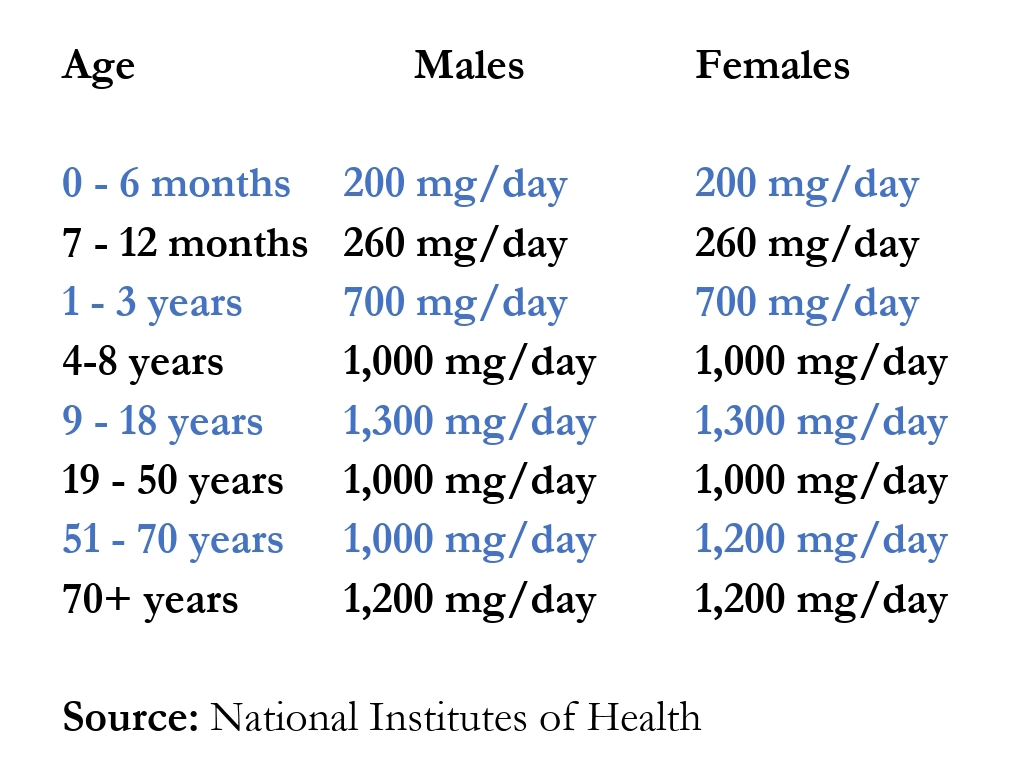
Calcium and Bone Health: The Ultimate Guide to Stronger Bones

What are the health benefits of calcium?
Calcium is a highly significant food nutrient that many people often forget to include in their diets. Calcium in the body benefits the body cells and systems, such as the nervous system, cardiovascular system, and muscles. Among other things, the body utilizes calcium to create strong, healthy bones and teeth as you age. In addition, the body also uses calcium to help with your blood clots, muscle contraction, and maintain the rhythm of your heartbeat.
If your diet is deficient in calcium, your body will draw it from your bones in order to maintain proper cell function. This might result in weakening bones or osteoporosis. Lack of calcium can cause mood disorders like irritability, anxiety, depression, and insomnia.
Even while calcium serves these important functions, many of us are unsure of how to effectively safeguard our bones and general health. The significance of calcium underscores the essence of knowing more about it. As far as calcium is concerned, the information and awareness of the recommended calcium intake, where it can be obtained, the magnesium, vitamin D, and other nutrients linked with calcium’s function, are very important. This awareness further helps to be more certain about our relationship with calcium, wherein we will be able to consume it in normal quantities each day. This kind of uncertainty makes one in two women and one in four men over the age of 50 shatter a bone as a result of osteoporosis.
Adequate calcium intake through diet is a necessity not just for the elderly, but a necessity for children, teenagers, and young adults, since we continue to build bone mass into our mid-20s. From that point forward, without enough calcium in our diets, we risk losing bone mass. More than that, including foods high in calcium in your diet, limiting foods that deplete calcium, and getting adequate magnesium and vitamins D and K will all help calcium perform its job, regardless of your age or gender.
The Calcium And Osteoporosis Connection
Inadequate supply of calcium leads to the loss of bone, and that ultimately leads to osteoporosis, called “silent” disease. Calcium is essential for numerous bodily functions. The primary function is to provide structural support to our bones and teeth. Calcium is crucial for various bodily functions. Our bones and teeth are supported structurally by calcium. Around 99% of the body’s calcium is stored in the bones and teeth, where it helps to maintain their strength and density.
The body uses calcium for the growth of new bone tissue during childhood and adolescence, aiding in the construction of a robust skeletal system. Old bone tissue is continually taken down and replaced with new bone as we age, undergoing a process known as remodeling. In this remodeling process, calcium plays a crucial role in keeping our bones strong and fracture-resistant.
The body starts to remove calcium from the bones to sustain normal bodily functions when it does not get enough calcium from the diet. This may eventually result in a loss of bone density and an elevated risk of osteoporosis, which poses major health hazards. Osteoporosis patients frequently don’t recover from falls, especially women in their 60s and beyond. In general, males are 5 to 10 years later than women in getting osteoporosis. However, they are still at risk. Osteoporosis is often preventable, and the major step to that is to ensure an adequate intake of calcium throughout life. In this regard, it is important that your diet contains enough calcium.
The Recommended Daily Intake Of Calcium
Depending on age and gender, different calcium intakes are advised daily; most individuals require between 1000 and 1300 milligrams (mg) of calcium daily.
Dairy products, including milk, cheese, and yogurt as well as leafy green vegetables, fortified foods, and supplements, are among dietary sources of calcium. It is important to note that other factors, such as vitamin D levels, which are crucial for calcium absorption, affect the body’s capacity to absorb calcium. As a result, it is advantageous to concentrate on a comprehensive strategy for bone health that includes eating foods high in calcium, getting enough vitamin D, and doing frequent weight-bearing exercises.
How Much Calcium Do You Need?

Sources of Calcium
According to medical professionals, the majority of your daily calcium intake should come from food. Experts have advised only using low-dose supplements to make up for any shortages. Calcium from food is more easily absorbed by the body than calcium from supplements. According to research, those who acquire their calcium through food have stronger bones even while those who use calcium supplements had greater average intakes. In addition, taking calcium supplements at excessive doses may make you more susceptible to heart problems and kidney stones.
Good Food Sources of Calcium
There are various excellent sources of calcium. These include dairy products, leafy green vegetables, some fish, oats and other grains, tofu, cabbage, summer squash, green beans, garlic, sea vegetables, and calcium-fortified foods like cereals and orange juice.
Calcium & Whole Milk Dairy: The Pros & Cons
There are certain downsides even if milk and other dairy products contain a lot of calcium in an extremely absorbable form.
Whole milk dairy products are often high in saturated: Although a growing body of research shows that consuming whole-milk dairy products is associated with lower levels of body fat and obesity, several well-known health organizations still advise cutting back on saturated fat and opting for low or non-fat dairy options. In order to make up for the flavor loss, low-fat and non-fat dairy products frequently also have a lot of hidden sugar, which can be far worse for your health and weight than the saturated fat it replaces.
Milk can contain high levels of estrogen: Research evidence revealed that there may be a connection between breast, prostate, and testicular cancer and the natural estrogens present in milk. Modern dairy practices, such as feeding cows artificial hormones and antibiotics, keeping them pregnant all the time, and milking them for more than 300 days a year, are a contributing factor to the issue. The level of hormones in the milk increases with the cow’s stage of pregnancy. Although organic milk might still be high in natural hormones, it comes from cows that are grass-fed and are not given synthetic hormones or other contaminants. Skim milk has a significantly lower level of hormones because both synthetic and natural hormones can be detected in milk fat.
Some people are lactose intolerant: Indicating that they cannot process the lactose, a sugar present in milk and milk products. Cramping, bloating, gas, and diarrhea are among the mild to severe symptoms. Beyond the discomfort it produces, lactose intolerance can prevent calcium from dairy products from being absorbed.
Tips For Increasing Calcium Intake
Including calcium rich food or snacks in meal will generally increase the daily intake of calcium.
Dairy Sources
Milk should be used instead of water in preparation of oatmeal or other cereals.
Replace some of the soups ingredients with milk. These ingredients may include squach, tomato, curries, pumpkin, etc.
You can consider milk as a base sauces or added to many sauces such as Béchamel sauce and Alfredo.
Milk or yogurt can as well be used in making whole-wheat pancakes and waffles.
Plain yogurt can be used to make a dressing or a dip, in a creative fashion, or experiment it with potatoes instead of sour cream.
Milk or yogurt can be added to a fruit smoothie.
Non-Dairy Sources
Soups, casseroles, and stir-fries can all benefit from the addition of greens. Choose kale, collard greens, turnip greens, mustard greens, beet greens, broccoli, and cabbage. To add more nutrients, season these and other meals with garlic, basil, thyme, oregano, and rosemary.
Eat salads with lush, dark greens at each meal. Choose romaine hearts, arugula, butter lettuce, mesclun, watercress, or red leaf lettuce instead of iceberg because it contains very little nutrition.
Include more vegetables in your meals, such as bok choy, asparagus, fresh green peas, broccoli, cabbage, and okra.
With canned fish with bones, such sardines and pink salmon, you can top salads or prepare sandwiches.
Include beans and other legumes in your meals. They taste great as the protein component of meals, in stews, chili, soup, and other dishes. Try black-eyed peas, black beans, tempeh, tofu, and other dried beans. Edamame is another snacking option.
Eat oats to start your day. Breakfast can be filled up with rolled or steel cut oats. Cinnamon can be added for a stronger Impact.
Snack on nuts and seeds like sesame and almonds. These can be included in your morning oatmeal as well.
Sandwiches on whole grain wheat bread can be ordered or made.
Beyond Calcium: Other Nutrients For Healthy Bones
Calcium alone is insufficient for strong bones and preventing osteoporosis. Your body needs a number of additional essential nutrients to properly absorb and utilize the calcium you consume.
Magnesium
Why it matters: Magnesium aids in calcium absorption and retention, which strengthens and builds bone and prevents osteoporosis. You must make sure you consume enough magnesium in your diet because your body does not do a good job of storing it.
What quantity do you need? 400–420 mg per day for adult men. 310–320 mg per day for adult women (higher during pregnancy).
How to increase the diet intake: Magnesium can be found in a variety of foods, including spinach, Swiss chard, summer squash, turnip and mustard greens, broccoli, sea vegetables, cucumbers, and celery, as well as nuts (particularly almonds and cashews), seeds (especially pumpkin, sesame, flax, and sunflower), whole grains, shellfish, legumes, and tofu. Reduce psychoactive substances such as alcohol and sugar, which cause more magnesium to be excreted.
Vitamin D
Why it is significant: Calcium absorption and blood calcium levels are controlled by vitamin D.
What quantity do you need? 600 IU (international units) each day, up to the age of 70. More than 70,800 IU daily.
Vitamin D is produced by your body when exposed to sunlight. Spend at least 15 minutes outside each day, and include vitamin D-rich foods like fortified milk, eggs, cheese, cereal, butter, cream, fish, shrimp, and oysters in your diet.
A note on vitamin D supplements: For healthy adults, getting enough vitamin D from food and sunlight is typically sufficient. In fact, new research indicates that supplementing with vitamin D is ineffective in lowering the likelihood of bone fractures in healthy persons over the age of 50. However, heed their advice and continue taking a supplement if you already have osteoporosis or if your doctor has advised you to take more vitamin D.
Phosphorous
Why it is significant: To help create bones, phosphorus works with calcium. However, it is crucial to strike the perfect balance because too much phosphorous may prevent your body from properly absorbing calcium and may even be poisonous.
How much do you need? For adults, 700 mg a day.
How to include it in your diet: Dairy, fish (cod, salmon, tuna), pork, poultry, lentils, nuts, and whole grains.
Vitamin K
Why it is important: It helps the body with calcium regulation and formation of strong bones.
How much do you need? 120 micrograms for Adult men daily, and 90 micrograms daily for adult women.
How to increase dietary intake: Simply consuming one or more servings of broccoli, Brussels sprouts, dark green lettuce, collard greens, or kale each day should be sufficient to provide you with the recommended daily allowance of vitamin K.
Vitamin C and vitamin B12
According to recent studies, vitamins C and B12 may also be crucial for maintaining bone health and preventing osteoporosis.
Vitamin C rich diets can perhaps stop bone deterioration. Citrus fruits including oranges and grapefruit, strawberries, kiwis, mangos, Brussels sprouts, and green bell peppers are also good sources.
Studies have also discovered a connection between vitamin B12 levels and osteoporosis and bone density. Seafood like salmon, haddock, and canned tuna as well as dairy products like milk, yogurt, eggs, and cottage cheese are excellent sources of B12.
Building Strong Bones & Preventing Osteoporosis
You can lessen the quantity of calcium you lose in addition to increasing the amount of calcium-rich foods in your diet by consuming less foods and other things that deplete your body’s calcium reserves.
Reduce your salt Intake. Consuming too much salt can cause bones to deteriorate and calcium to be lost. Reduce processed meats, fast meals, packaged and convenience foods, which are frequently high in sodium. Use herbs and spices to improve the flavor of food instead of salt.
Reduce your caffeine intake. Calcium loss can occur if you consume more than two cups of coffee every day. When calcium levels are already low in older adults, the amount lost can have a major effect. By consuming coffee with milk, the effects might be somewhat lessened.
Watch your alcohol intake. Alcohol consumption alters your body’s calcium balance in a number of ways and prevents calcium from being absorbed. In essence, try to reduce your alcohol intake significantly.
Avoid soft drinks. Your body removes calcium from your bones and excretes it in order to balance the phosphates in soft beverages. Instead, choose calcium-fortified orange juice or water.
Exercise And Bone Health
Physical exercise, especially weight-bearing activities like walking, dancing, jogging, weightlifting, stair climbing, racquet sports, and hiking, are crucial for developing and keeping strong bones. Choose an activity that you like to do and commit to doing it frequently.
Calcium Supplements: What You Need To Know
The best source of calcium is food, but you can also take supplements to make up any deficiency in your diet. But it is crucial to take only what you need.
A calcium compound with a high absorption rate is calcium citrate.
Calcium citrate is more readily absorbed than calcium ascorbate and calcium carbonate.
Be smart about calcium supplements:
Take no more than 500mg at once. It is recommended to take calcium in small amounts throughout the day as your body can only absorb a certain amount at once.
Never take more than what is advised for your age group. Consider how much calcium you consume through meals. Keep in mind that more is not always better because it might harm the heart and have other detrimental impacts on health.
Take your calcium supplement with food. The best calcium absorption occurs when all supplemented forms are taken with food. Choose calcium citrate if it isn’t possible to take a supplement with food.
Purity is important. The labels of calcium supplements that say “purified” or, if you live in the US, with the USP (United States Pharmacopeia) emblem are the finest to choose from. Without the USP sign, avoid supplements made from unpolished oyster shell, bone meal, or dolomite as they might be high in lead or other hazardous metals.
Consider the side-effects. Some people react negatively to calcium supplementation and have constipation, gas, and acid reflux as a result. Change from calcium carbonate to calcium citrate to prevent acid rebound. Try increasing your consumption of water and high-fiber foods to relieve flatulence or constipation.
Analyze any potential medication interactions. Supplements containing calcium, magnesium, and vitamin K may interact with other vitamins and medications you are taking, including blood thinners, antacids, certain diuretics, heart medications, and some cancer therapies. Inquire about potential interactions with your physician or pharmacist. It is not advisable to take calcium along with any drugs that you take on an empty stomach.

